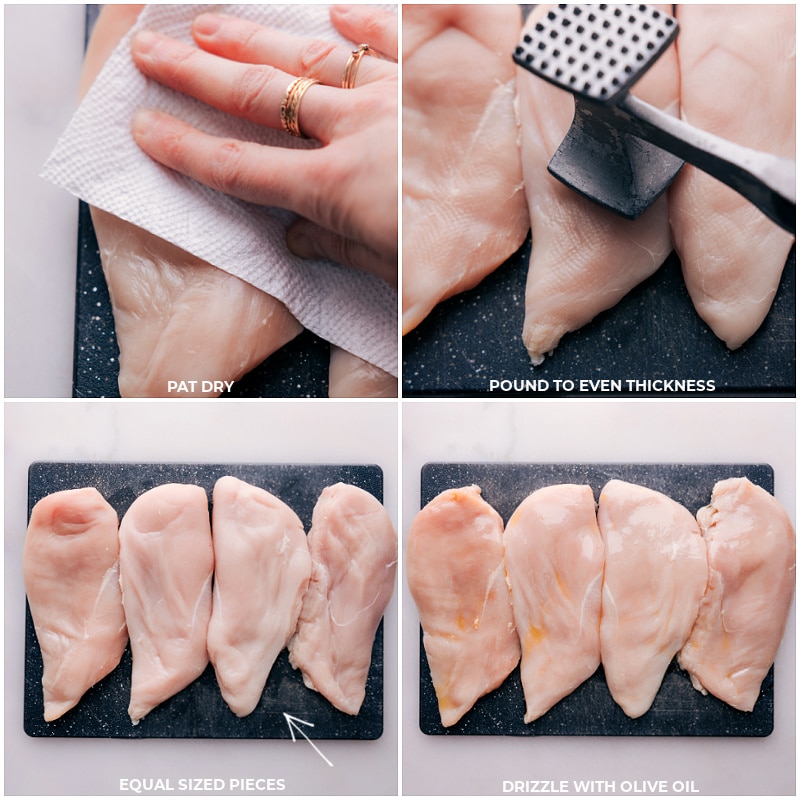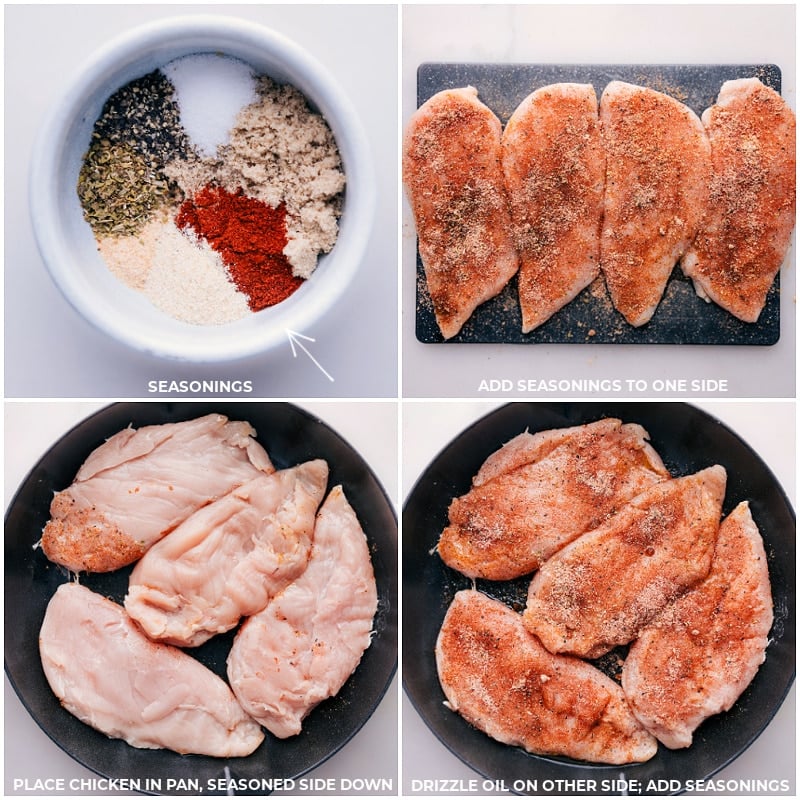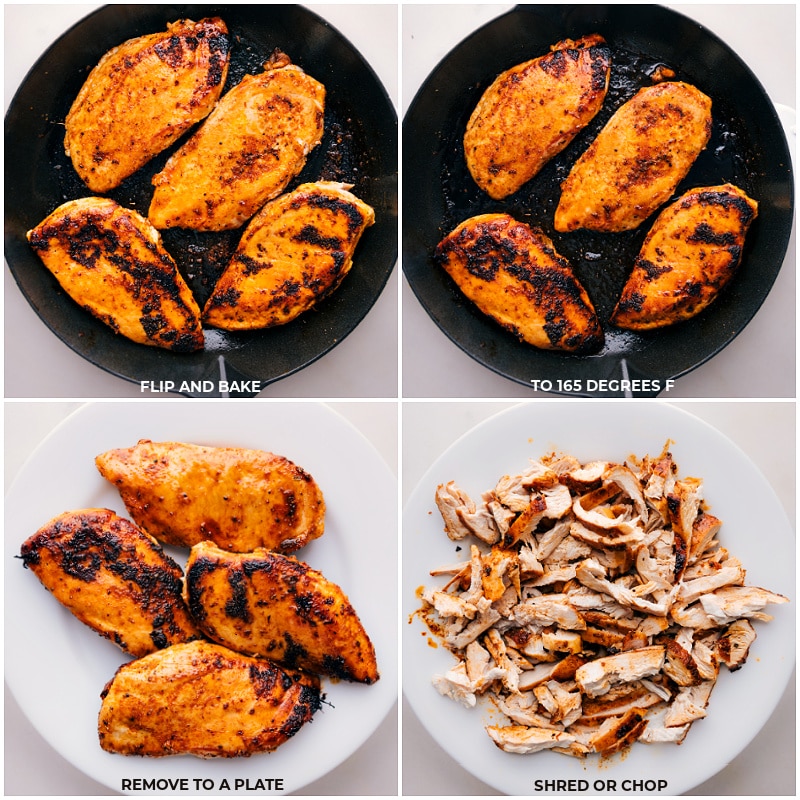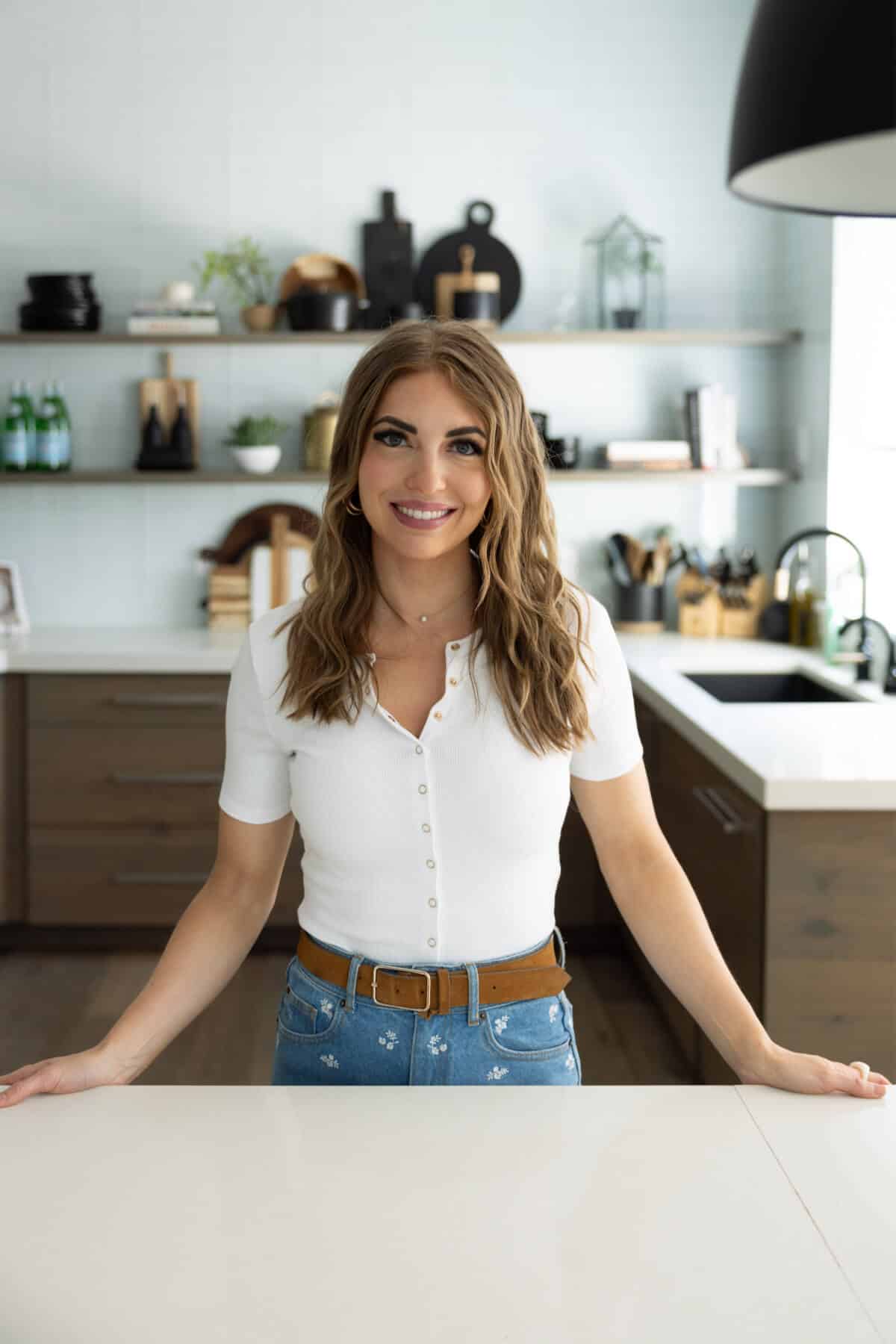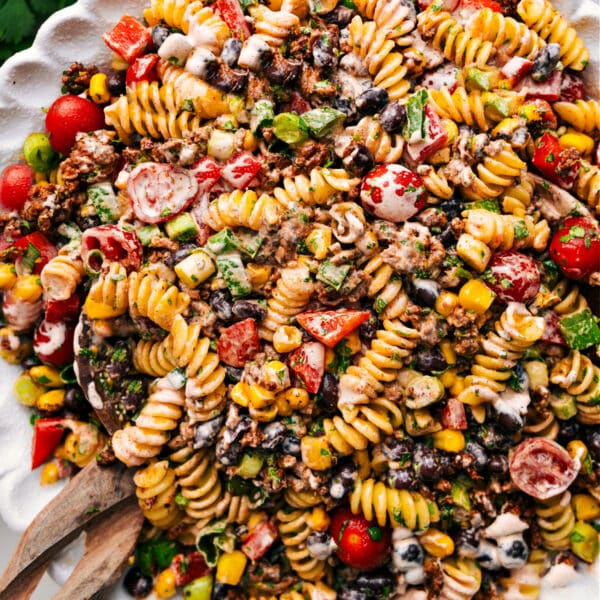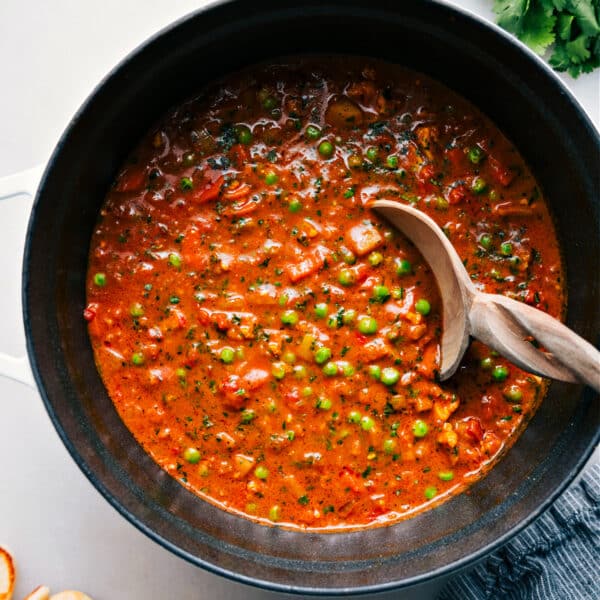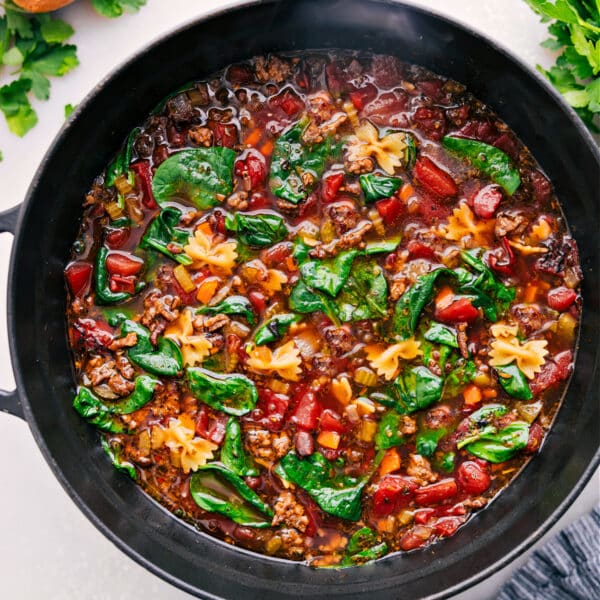Here’s our simple and delicious recipe for Baked Chicken Breasts! This recipe takes boneless, skinless chicken breasts and turns them into a flavorful and juicy main dish– perfect for any night of the week. This recipe works for any recipe calling for prepared chicken, including weekly meal prepping. Enjoy the chicken right out of the oven or shred, chop, or dice this chicken and use it as needed!
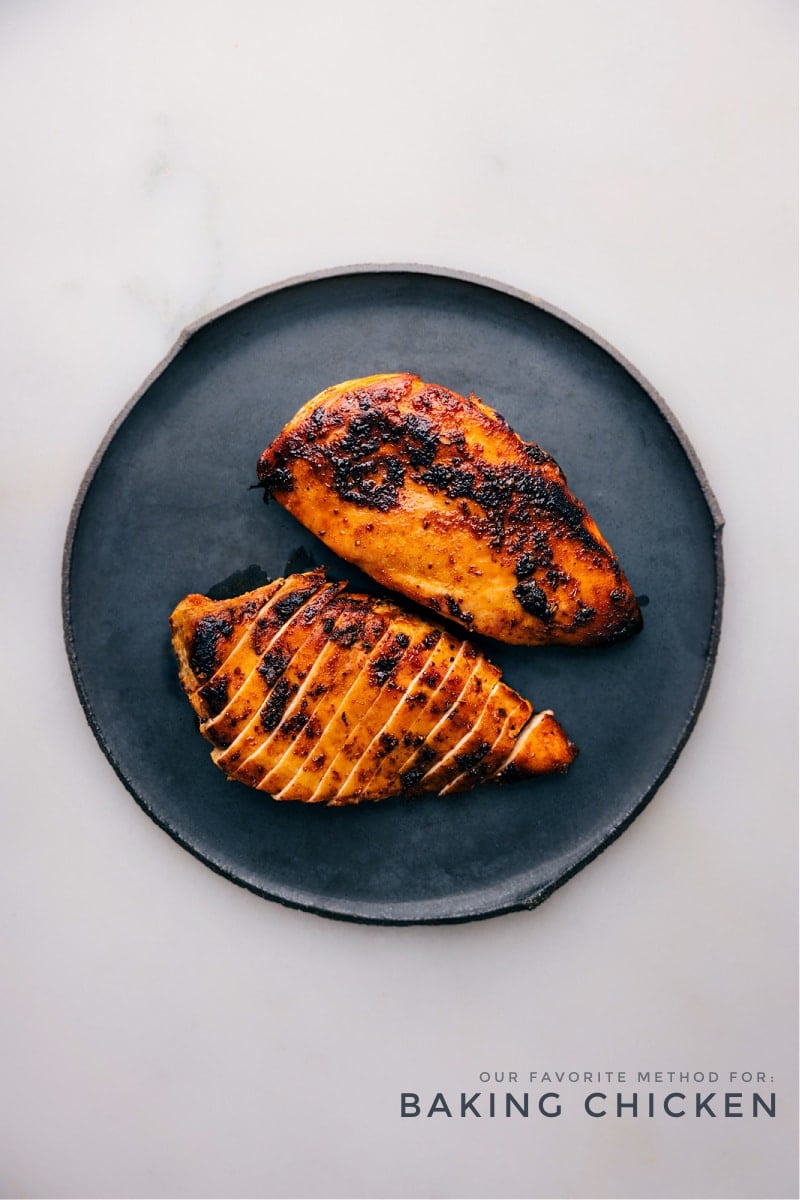
How To Use Baked Chicken Breasts
Not only is this chicken bursting with flavor that results in juicy chicken, but it’s also incredibly simple to make. We season the chicken breasts with a mix of everyday spices and then sear them in a cast iron skillet. Then we bake them until perfectly cooked through.
These tender chicken breasts can be enjoyed as a nutritious main dish alongside some roasted veggies or a garden salad, and the uses don’t stop there. In fact, Baked Chicken Breasts can be used in a variety of other meals and are a great meal-prepping option.
To meal prep, cook the chicken ahead of time and slice, dice, or shred for salads, wraps, or sandwiches throughout the week. Alternatively, you can dice or chop the chicken and use it in casseroles, soups, and stews that call for already-cooked chicken.
We make this recipe nearly constantly–it’s our go-to choice for recipes throughout the week or for weekly meal prepping!
Invaluable Tools For Making Perfect Baked Chicken Breasts:
When it comes to making the perfect Baked Chicken Breasts, I can suggest a few key tools to help you achieve success. Here are the top four tips for the best Baked Chicken Breasts:
- Food scale: Weighing your chicken ensures that each piece cooks evenly since you can make sure all of the pieces are roughly the same size.
- Meat mallet: Using a meat mallet to pound your chicken breasts is the secret to juicy chicken! Pounding the thicker parts of the chicken can help bring the whole piece to a more even thickness, which means that it will cook more evenly in the oven. This can help prevent dry, overcooked chicken and ensure that your baked chicken turns out perfectly every time. Note: Pounding doesn’t mean beating it to a pulp! Use the mallet to smooth and press the chicken so that it’s an even thickness.
- Cast-iron skillet: Searing the chicken before it goes in the oven helps develop a nice crust on the outside. That helps lock in moisture and flavor. A cast-iron skillet goes from the stovetop to the oven, which means you can use the same pan for the whole cooking process.
- Meat thermometer: Nobody wants dry, overcooked chicken yet nobody wants raw chicken, either! A meat thermometer lets you know when the chicken is cooked to the proper temperature. This is especially important with chicken, which needs to be cooked all the way through to prevent foodborne illness.
How Long To Bake Chicken Breast:
If your chicken breasts are extra large, cut them in half to get two smaller filets. With 6-ounce fillets, the chicken will need to cook for five minutes on the stovetop and then approximately 10 more minutes in the oven. For slightly larger filets, you’ll need to add a bit more time to ensure they are cooked through. Here’s where a meat thermometer comes in handy!
Why Sear First?
We like searing the chicken first for three reasons:
- Flavor: When you sear the chicken in a hot pan, it creates a delicious crust on the outside of the chicken that adds flavor and texture to the final dish. This process called the Maillard Reaction, is a chemical reaction that creates new flavor compounds and browns the surface of the chicken, creating that delicious crust.
- Moisture: Searing the chicken before baking seals the surface of the chicken and prevents the moisture from escaping as it cooks in the oven. That keeps the chicken moist.
- Timing: Searing the chicken before baking saves time. While the oven is preheating, you can get started by searing the chicken on the stovetop. This way, you don’t have to wait around for the oven to preheat before starting the cooking process. By the time you finish searing the chicken, the oven should be heated to the desired temperature, and you can transfer the chicken directly to the oven to finish cooking. Also, searing reduces the overall time needed in the oven. This time-saving technique helps you get dinner on the table faster.
Searing the chicken before baking results in a more flavorful and moist chicken breast. However, it is possible to bake the chicken without searing it first, and still end up with a tasty and juicy chicken breast. Read on for more info:
What If I Don’t Have A Cast Iron Skillet?
If you don’t have an oven-safe or cast-iron skillet, don’t worry; you can still make this healthy Baked Chicken Breast recipe.
Instead of searing the chicken first, simply cook it all the way through in the oven. Begin by lining a tray with parchment paper. Rub 1-1/2 teaspoons of oil on each side of the chicken breasts and then apply the seasoning mix evenly on both sides. Place the chicken on the prepared tray and bake it for 15-20 minutes, or until the internal temperature reaches 160 degrees F (carryover heat will take it to 165 degrees). Allow the chicken to rest for about 5 minutes before serving.
Variations
Fun Ideas To Change Things Up
- Lemon and herb chicken: Add some lemon zest and dried herbs such as thyme, rosemary, and parsley to the seasoning mix. Serve breasts with a wedge of lemon and some fresh minced herbs.
- Cajun-style chicken: Add some Cajun seasoning to the mix, along with a pinch of cayenne pepper for some heat. Serve with rice and beans for a tasty Cajun-inspired meal.
- Honey mustard chicken: Make this Honey Mustard Salad Dressing and then brush it over the baked chicken breasts after removing it from the oven.
- Pesto chicken: Roast some cherry tomatoes alongside the chicken. Once you take the chicken out of the oven, add a thin slice of mozzarella cheese and broil for 30 seconds. Serve cheesy chicken with the roasted tomatoes and a scoop of pesto.
- Switch up the seasonings: Try different seasoning blends depending on what you’re craving or how you want to use this chicken. Try our Taco Seasoning or Fajita Seasoning instead!
Storage
Storage and Reheating
To store Baked Chicken Breasts, first let them cool down to room temperature. Then, you can either store them in an airtight container in the refrigerator or freezer.
Refrigerated, the chicken can be stored for up to 4 days. It’s best to slice or shred the chicken before storing it, so it’s easy to use in salads, sandwiches, or other recipes. You can also store the chicken breasts whole, but be sure to wrap them tightly in plastic wrap or aluminum foil.
Frozen, the chicken can be stored for up to 2-3 months. Once again, slice or shred the chicken before freezing for easier use later on. Be sure to label the container with the date so you can keep track of how long it’s been in the freezer.
When reheating, it’s best to do so in the oven or on the stovetop, rather than the microwave, to prevent the chicken from becoming dry or tough.
Use Baked Chicken Breast Meat In One Of These Recipes:
- Chicken Pozole in 30 minutes!
- Cashew Chicken with a quick stir-fry sauce
- Chicken Noodle Casserole with a crunchy topping
- Teriyaki Chicken Salad with a three-ingredient dressing
- Chicken Curry Rice Soup with veggies
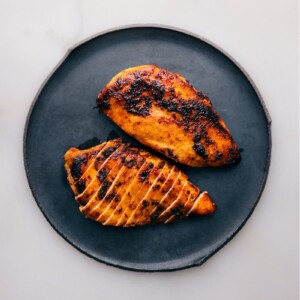
Baked Chicken Breast
Equipment
- Food scale see note 1
- Meat mallet
Ingredients
Instructions
- Preheat oven to 425°F, positioning rack in the center of the oven. In a small bowl, mix all seasonings with 1/2 teaspoon each of salt and pepper.
- Use a meat mallet (or the bottom of a frying pan) to pound chicken at the thickest part to be even with the rest of the piece (filets should be just over 1/2-inch thick throughout). Pat filets dry with a paper towel.
- Drizzle 1-1/2 teaspoons oil on 1 side of the chicken breasts. Gently rub in the oil. Sprinkle 1/2 of the seasoning mix on top and gently press in.
- If you don’t have an oven-safe pan, see note 3. Place an empty, large cast-iron pan on the stove over medium-high heat for 1 minute. Use tongs to place seasoned chicken in the pan, seasoned side down. Immediately add remaining 1-1/2 teaspoon oil and remaining seasoning mix to the other side of the chicken filets. Cook exactly 5 minutes, then flip filets and place pan with chicken in the fully preheated oven for 9–15 minutes or until internal temperature hits 160°F (carryover heat will take it to 165°F).
- Remove from oven and immediately transfer chicken from the pan to a cutting board to avoid overcooking. Let rest for 5 minutes before slicing, shredding, or serving.
Recipe Notes
-
- Food scale: Weighing your chicken ensures that each piece cooks evenly since you can make sure all of the pieces are roughly the same size.
- Meat mallet: Using a meat mallet to pound your chicken breasts is the secret for juicy chicken! Pounding the thicker parts of the chicken can help bring the whole piece to a more even thickness, which means that it will cook more evenly in the oven—preventing dry, overcooked chicken.
- Cast-iron frying pan: Searing chicken in a cast-iron skillet gives you a flavorful crust that locks in moisture and flavor. Since it’s oven-safe, you can use the same pan from stovetop to oven.
- Meat thermometer: A meat thermometer is an essential tool for ensuring that your chicken is cooked to the proper temperature.
Nutrition
Nutrition information is automatically calculated, so should only be used as an approximation.
